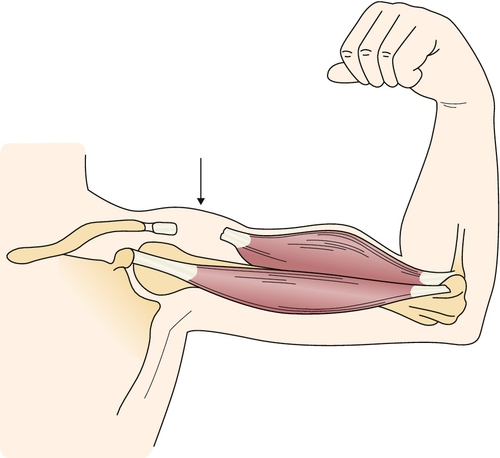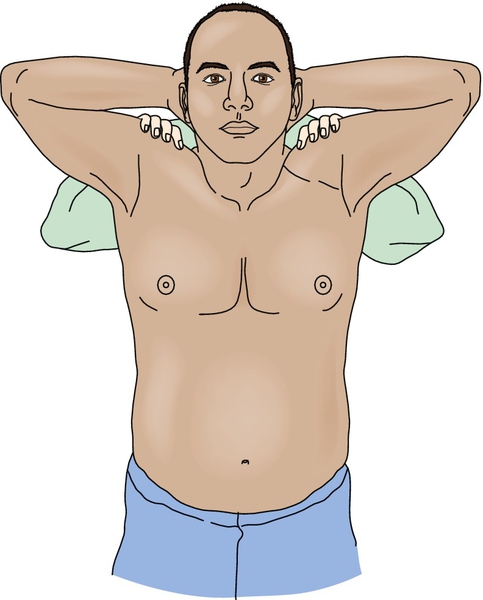CHAPTER 13
Biceps Tendon Rupture
Definition
Biceps tendon rupture is either complete or partial disruption of the tendon of the biceps brachii muscle that can occur proximally or distally. The more common proximal ruptures are frequently seen in older individuals who have had chronic tendinosis of the long head of the biceps tendon associated with concomitant rotator cuff disease and degenerative joint disease of the shoulder [1] (Fig. 13.1). The incidence is 1.2 per 100,000 patients, with a majority on the dominant side of men who smoke and are in the fourth decade of life [2]. Most cases involve the long head of the biceps brachii and are manifested as a partial or complete avulsion from the superior rim of the anterior glenoid labrum [3]. Rupture of the proximal biceps tendon represents 90% to 97% of all biceps ruptures; it almost exclusively involves the long head [4] and is 7.5 times more likely in smokers [2].

Recent cadaveric study suggests that the relative avascularity of the long head of the biceps tendon may be a risk factor, as seen in many other tendon ruptures. Supplied through its osteotendinous and musculotendinous junctions and rarely branches from the anterior circumflex humeral artery traveling in a mesotenon, the long head of the biceps tendon has a hypovascular region in the border of two adjacent vascular territories. This region of limited arterial supply, 1.2 to 3 cm from the tendon origin, extends midway through the glenohumeral joint to the proximal intertubercular groove [5]. The distal biceps rupture is relatively uncommon and typically occurs in middle-aged men, although acute traumatic ruptures may occur in younger individuals or in anyone engaged in predisposing activities, such as forceful explosive contraction of the biceps. Patients with a distal biceps tendon rupture carry a risk of at least 8% for a rupture on the contralateral side [6]. This often develops suddenly with stressing of the flexor mechanism of the elbow. Distal biceps rupture usually occurs as a single traumatic event, such as with heavy lifting; it is often an avulsion of the tendon from the radial tuberosity, but it can also occur as a midsubstance tendon rupture [7].
Symptoms
Proximal ruptures are often asymptomatic and are commonly discovered with awareness of distal migration of the biceps brachii muscle mass, or they may occur suddenly by a seemingly trivial event. Often, individuals will note an acute “popping” sensation. The patient often takes one finger and points directly to the bicipital groove when describing the pain. Edema and ecchymosis may be seen with tendon rupture but also with other regional pathologic processes. The proximal ruptures are typically less painful but can be preceded by chronic shoulder discomfort [8]. An acute distal rupture is often associated with pain at the antecubital fossa that is typically aggravated by resisted elbow flexion. The pain is usually sharp initially but improves with time and is often described as a dull ache [9]. Swelling, distal ecchymosis, and proximal migration of the biceps brachii muscle mass accompany this injury with a magnitude dependent on the degree of injury. Younger, healthy patients may often present with a cosmetic rather than a functional complaint.
Physical Examination
Visual inspection of the biceps brachii, including comparison with the unaffected limb, is usually the first and most critical element in the physical examination of this condition. Advances in portability, training, and technology have led to a larger trend among physicians in various specialties to integrate diagnostic musculoskeletal ultrasound into the early phases of routine clinical assessment [10].
The Ludington test [11] is a recommended position in which to observe differences in the contour and shape of the biceps (Fig. 13.2). Diagnosis of complete ruptures is relatively easy; patients often come in aware of the biceps muscle retraction. Partial ruptures exist along a spectrum and can be more difficult to diagnose. The clinician should also assess for the presence of ecchymosis or swelling as a sign of acute injury. Palpation for point tenderness will often reveal pain at the rupture site. An effort should also be made to determine whether the rupture is complete by palpation and observation of the tendon. Thorough assessment of the shoulder and elbow should be made for range of motion and laxity. The Yergason [12] and Speed [13] tests (see Chapter 12), which are used in the assessment of bicipital tendinitis, are also recommended. Posterior dislocation of the long head of the biceps tendon has been reported [14] and may share some common physical examination findings but not muscle retraction.

In patients with inconsistent physical examination findings and questionable secondary gains, the American Shoulder and Elbow Surgeons subjective shoulder scale [15], a standardized scale of shoulder function with patient and physician components, has demonstrated acceptable psychometric performance for outcomes assessment in patients with shoulder instability, rotator cuff disease, and glenohumeral arthritis [16]. It is important to examine the entire shoulder and to keep in mind that it is a complex, inherently unstable, well-innervated joint that tends to function, and fail, as a unit; therefore, additional lesions that are the true pain generator may be evident. One study [17] looking at shoulder magnetic resonance findings showed no statistical relationship between the level of disability and either biceps tendon rupture or biceps tendinopathy; rather, disability was linked to supraspinatus tendon lesions and bursitis.
A thorough neurologic and vascular examination is performed, and findings should be normal in the absence of concomitant problems. Caution should be used with strength testing or end-range motion to avoid worsening of an incomplete tear.
Functional Limitations
The functional limitations are generally relatively minimal with proximal biceps rupture [18







